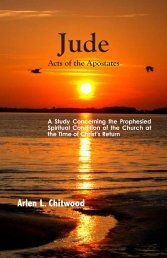Signs in John's Gospel - The Lamp Broadcast
Signs in John's Gospel - The Lamp Broadcast
Signs in John's Gospel - The Lamp Broadcast
You also want an ePaper? Increase the reach of your titles
YUMPU automatically turns print PDFs into web optimized ePapers that Google loves.
Structure of John’s <strong>Gospel</strong> 21<br />
or draw attention to someth<strong>in</strong>g or someone. And the absence of the<br />
article, on the other hand, is used to call attention to quality or character.<br />
For example, the word for “God” appears twice <strong>in</strong> John 1:1. <strong>The</strong><br />
first time there is a def<strong>in</strong>ite article before the word, call<strong>in</strong>g particular<br />
attention to identity; but the second time there is no article before the<br />
word, call<strong>in</strong>g particular attention to quality or character.<br />
A question surround<strong>in</strong>g Christ’s Div<strong>in</strong>ity is not an issue <strong>in</strong> this<br />
verse. Christ’s Div<strong>in</strong>ity is an established fact, established <strong>in</strong> this verse<br />
and elsewhere <strong>in</strong> Scripture. Rather, the word for “God,” preceded by<br />
the article, has to do with Div<strong>in</strong>e personality [identity]; and the same<br />
word not preceded by the article, has to do with Div<strong>in</strong>e essence [quality<br />
or character].<br />
Plac<strong>in</strong>g an <strong>in</strong>def<strong>in</strong>ite article before the second use of the word for<br />
“God” <strong>in</strong> the English translation does more than reflect negatively on<br />
Christ’s Deity. In reality, it does away with the reason for the omission<br />
of the article. Thus, leave the verse exactly as the Spirit of God moved<br />
John to pen the verse as he began his gospel, understand<strong>in</strong>g the verse<br />
<strong>in</strong> accord with established rules of Greek grammar.)<br />
John 1:1 deals with the Deity of Christ two ways:<br />
1) <strong>The</strong> Word, which became flesh (v. 14), is seen as God<br />
Himself becom<strong>in</strong>g flesh.<br />
2) <strong>The</strong> Word, seen as both God and His Son, was with<br />
God <strong>in</strong> the beg<strong>in</strong>n<strong>in</strong>g.<br />
<strong>The</strong> first has already been dealt with <strong>in</strong> the preced<strong>in</strong>g <strong>in</strong>dented<br />
material, and the second has to do with the Greek word eimi,<br />
translated “was.” This Greek word appears three times <strong>in</strong> verse<br />
one and once <strong>in</strong> verse two. <strong>The</strong> word is used <strong>in</strong> a timeless sense <strong>in</strong><br />
these verses — a sense with respect to an existence without a beg<strong>in</strong>n<strong>in</strong>g<br />
or an end<strong>in</strong>g (e.g., note “I am” <strong>in</strong> John 8:58, a translation of eimi;<br />
or the word is used <strong>in</strong> a double respect <strong>in</strong> the Septuag<strong>in</strong>t version<br />
of Ex. 3:14, with God identify<strong>in</strong>g Himself to Moses through this<br />
usage — “I am that I am”; or, “I am Who I am”; or, “I am the<br />
Be<strong>in</strong>g [the One exist<strong>in</strong>g throughout all time, past, present, future]”).<br />
To contrast, note verse three where a different word is used three<br />
times <strong>in</strong> the Greek text — g<strong>in</strong>omai — though translated twice the



